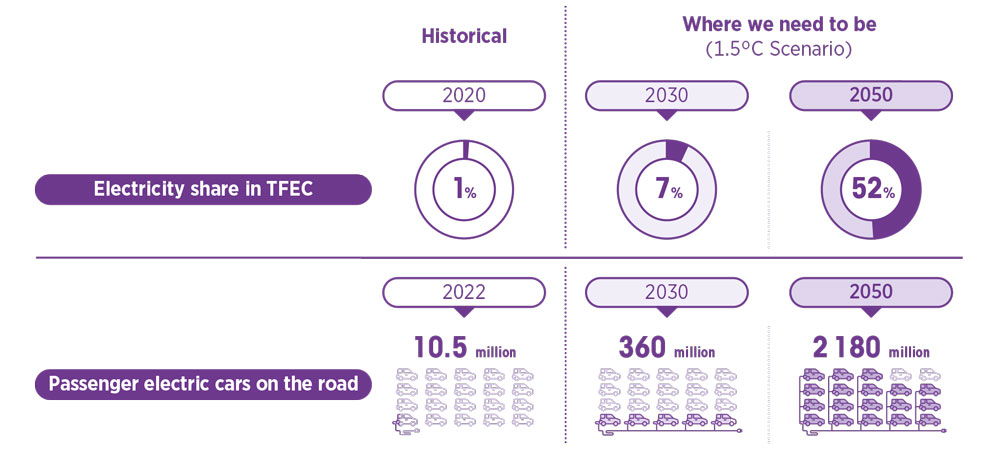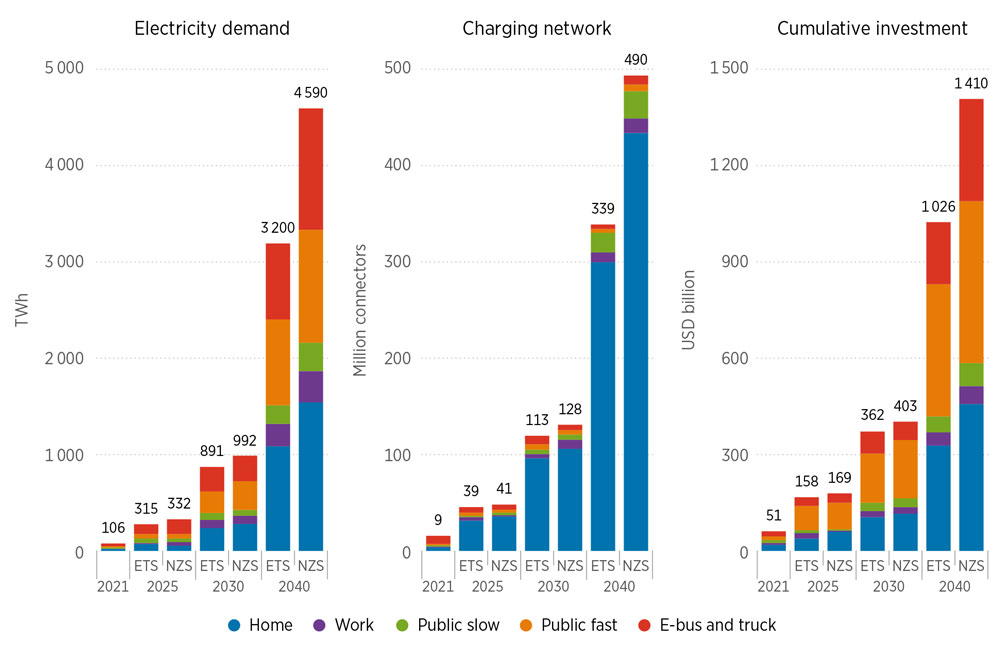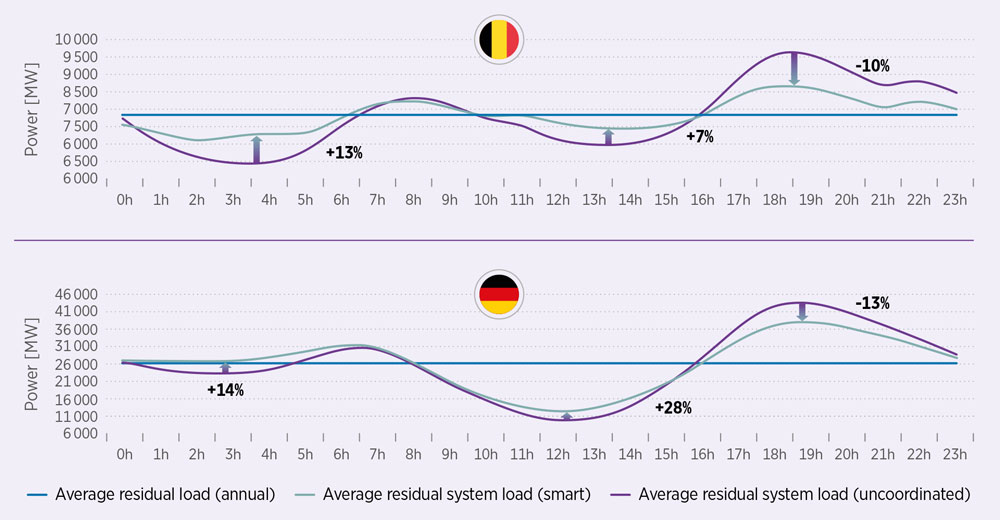Status and pace of progress
Adoption of new electric vehicles (EVs) is accelerating. Under IRENA's 1.5°C Scenario, the number of electric passenger cars would grow to 360 million by 2023, and 2 180 million by 2050 (IRENA, 2023). The transition is being boosted by planned bans on the sales of new fossil fuel– powered vehicles, net-zero emissions targets, climate policies and other pollution-driven regulations. At the same time, as technological progress and innovation are lowering the cost of EVs, users are realising the benefits of the technology (such as less noise pollution, a better driving experience and the convenience of charging while parked) and modifying their consumption behaviour by making more sustainable decisions.
Meanwhile, the rapid growth of EVs poses a challenge for the electricity system: Can it cope with the additional demand? IRENA estimates that electricity’s share of total final energy consumption in the transport sector will grow to 7% by 2030 and to 52% by 2050 (IRENA, 2023) (Figure 1.1). As a result, the global electricity demand from all EVs is expected to reach almost 3 000 terawatt hours (TWh) by 2040 in BloombergNEF’s (BNEF) Economic Transition Scenario (BloombergNEF, 2021a) and 4 500 TWh in the Net Zero Scenario, up from 106 TWh in 2021.
The BNEF scenarios show that about 35% of EV charging will be done at home in 2040. Public fast charging will make up about 24% of the total, with slow public chargers and workplace charging comprising another 7% each. Ultra-fast charging for e-buses and trucks will account for 27% of the electricity demand. All of these will require major investments in charging infrastructure; under IRENA's 1.5°C Scenario, electric charging infrastructure would require a cumulative investment of USD 9 trillion through 2050 (IRENA, 2023). BNEF estimates that, cumulatively, USD 1-1.4 trillion will have to be invested in charger hardware, installation and maintenance. Fast charging – from 50 kilowatts (kW) to 1 megawatt (MW) – for passenger and commercial vehicles, which accounted for 70% of all investments in 2022, will drop to around 60% of spending in 2040 (BloombergNEF, 2021a).
FIGURE 1.1 Electricity share in transport and EV stock in IRENA’s 1.5°C Scenario

Note: TFEC = total final energy consumption.
Growth in charging infrastructure will help to accelerate EV sales by reducing drivers’ range anxiety and increasing confidence in EVs (Figure 1.2).
FIGURE 1.2 Global EV demand for electricity, charging infrastructure and investment

Notes: Excludes two- and three-wheelers. Investment includes hardware, installation and maintenance costs.
ETS = Economic Transition Scenario; NZS = Net Zero Scenario.
Norway’s experience with EVs points to the path ahead, although the country enjoys some attributes that are by no means universally shared (Box 1.1).
BOX 1.1 Norway’s progress in electrifying mobility
Norway has made remarkable progress in increasing its share of EVs, with the share rising to almost 86% of cars sold in 2021. By 2021, 16% of all vehicles were electric. The rapid growth has been driven by a large range of incentives, from tax breaks and exemptions to waivers on road tolls and ferry fees.
Norway is uniquely positioned to power its EVs with clean electricity. Not only is nearly 98% of the country’s electricity generated from renewable sources, chiefly hydropower plants, but the total number of EVs in Norway is small compared with Chinese and US markets. If all 2.7 million cars in Norway were EVs, they would use only 5-6% of the country’s annual hydropower output (Paulraj, 2019). In addition, hydropower is more flexible than variable renewables like solar and wind, reducing the challenges of charging EVs. For other countries, however, smart electrification also has an important role to play.
1.1 The importance of smart electrification for decarbonising mobility
A major challenge to widespread EV adoption is ensuring that the power grid can supply the increased demand with renewable-based electricity. Meeting this challenge requires smart electrification strategies that will increase renewable integration and reduce peak loads, thus decreasing grid congestion. Smart electrification also provides important operational benefits for power systems through flexibility and storage services. These benefits include reducing greenhouse gas emissions, peak loads and operational costs, and the curtailment of variable renewable generation. A corollary of smart electrification is smart charging to cut the need for additional generation, transmission and distribution capacity, all in the interest of minimising investment costs. In uncontrolled (or unco-ordinated) charging, EVs begin charging as soon as they are connected to a charging point. In smart charging, by contrast, intelligent algorithms optimise the charging process, considering electricity prices (or renewable generation), local congestion and battery ageing. Where electricity prices vary over time, smart charging allows EV owners to charge when prices are lower.
All these benefits increase further when EVs can supply power back to the grid (vehicle to grid [V2G]), thus reducing the need for inefficient peaking generators.
Figure 1.3 summarises the results from several studies of the impact of charging options on the power system. Box 1.2 explores these impacts in Belgium and Germany.
FIGURE 1.3 Impact of EV smart charging on the electricity grid

At the distribution grid level, smart charging can avoid overloading distribution components and assets, improve voltage quality and reduce energy losses. These benefits also make it possible to increase the use of distributed energy resources (DERs) without violating network operational constraints.
While studies of the operational value of smart charging on the distribution system are difficult to compare (Anwar et al., 2022), two common findings are:
- Smart charging can noticeably reduce peak loads and congestion in the distribution grid. These benefits increase as more EVs are connected and are greater with bidirectional smart charging (V2G) than unidirectional smart charging (V1G).
- Smart charging can reduce voltage drops caused by uncontrolled EV charging, especially at high levels of EV penetration. The provision of reactive power from EVs also leads to greater improvements in distribution system voltage.
For power system operations (Anwar et al., 2022), the benefits of smart charging include:
- Cost savings of USD 15-360 per EV per year.
- CO₂ emission reductions of 0.1-2.5 tonnes per EV per year.
- Peak load reductions of 0.2-3.3 kW per EV.
- Reductions in the curtailment of variable renewable energy (VRE) of 23-2 400 kWh per EV per year.
Realising these benefits will depend on the application of business models capable of extracting the maximum amount of grid flexibility from mobility.
BOX 1.2 Impact of smart charging in Belgium and Germany
The Belgian transmission system operator Elia performed an in-depth analysis of the impact of electric passenger vehicles on the power system. The study found that smart charging – in which algorithms are used to optimise the charging process, considering electricity prices (or renewable generation), local congestion and battery ageing – increased the integration of renewables, reduced peak loads and saved drivers money.
Smart charging would enable the integration of an additional 1.4-1.7 TWh of renewable energy sources by 2030, increasing renewable generation by 30% in Belgium and 37% in Germany. That, in turn, would reduce the system load that would have to be supplied from non-renewable generation, making it easier to transition towards a fully decarbonised power system.
Smart charging can shift charging away from times of peak demand, promoting charging overnight or at times when the supply of renewable energy is high. Unmanaged charging would raise demand by 1.2 gigawatts (GW) in Belgium and 6.5 GW in Germany by 2030, whereas smart charging would reduce 2030 peak load by 13% in Germany and 10% in Belgium, as Figure 1.4 shows.
By shifting charging to times when electricity prices are lower, EV owners can lower their annual electricity costs by 15% (EUR 30-35) when electricity flows only from the grid to their cars and by 25% (EUR 50-55) when EVs also supply electricity to the grid. These savings might increase further after 2030, as rising levels of renewable energy increase the spread between high and low prices at different times of day.
FIGURE 1.4 Impact of EV smart charging on electricity grids in Belgium and Germany
